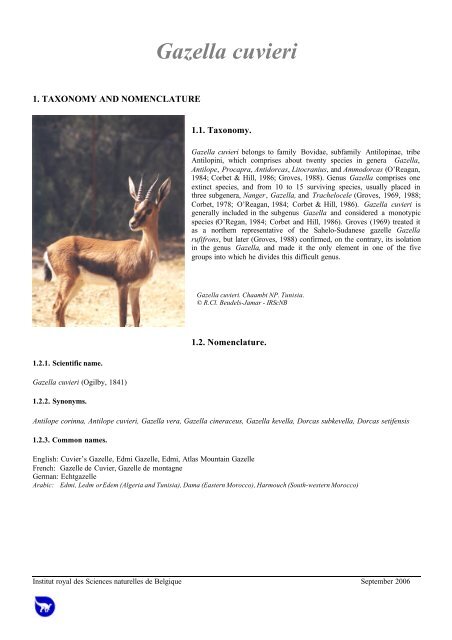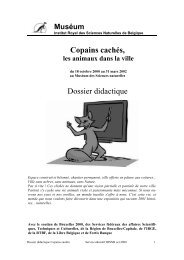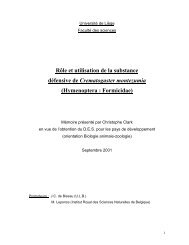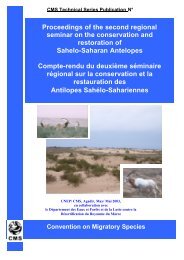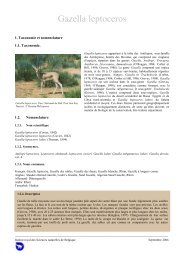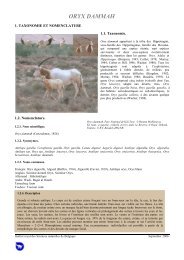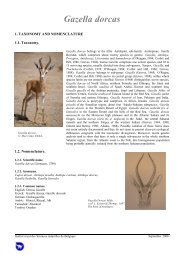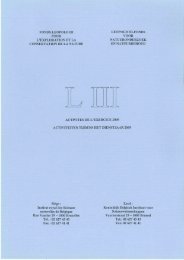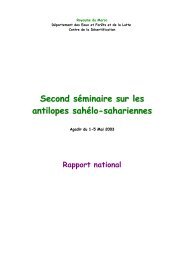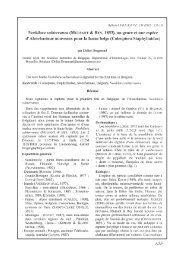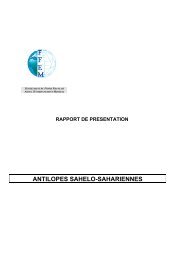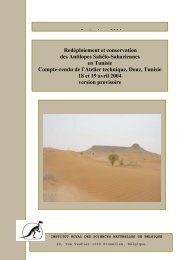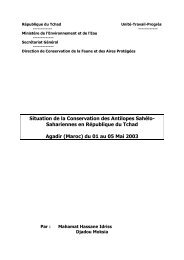Gazella cuvieri - Institut Royal des Sciences Naturelles de Belgique
Gazella cuvieri - Institut Royal des Sciences Naturelles de Belgique
Gazella cuvieri - Institut Royal des Sciences Naturelles de Belgique
Create successful ePaper yourself
Turn your PDF publications into a flip-book with our unique Google optimized e-Paper software.
1. TAXONOMY AND NOMENCLATURE<br />
1.2.1. Scientific name.<br />
<strong>Gazella</strong> <strong>cuvieri</strong> (Ogilby, 1841)<br />
1.2.2. Synonyms.<br />
<strong>Gazella</strong> <strong>cuvieri</strong><br />
1.1. Taxonomy.<br />
<strong>Gazella</strong> <strong>cuvieri</strong> belongs to family Bovidae, subfamily Antilopinae, tribe<br />
Antilopini, which comprises about twenty species in genera <strong>Gazella</strong>,<br />
Antilope, Procapra, Antidorcas, Litocranius, and Ammodorcas (O’Reagan,<br />
1984; Corbet & Hill, 1986; Groves, 1988). Genus <strong>Gazella</strong> comprises one<br />
extinct species, and from 10 to 15 surviving species, usually placed in<br />
three subgenera, Nanger, <strong>Gazella</strong>, and Trachelocele (Groves, 1969, 1988;<br />
Corbet, 1978; O’Reagan, 1984; Corbet & Hill, 1986). <strong>Gazella</strong> <strong>cuvieri</strong> is<br />
generally inclu<strong>de</strong>d in the subgenus <strong>Gazella</strong> and consi<strong>de</strong>red a monotypic<br />
species (O’Regan, 1984; Corbet and Hill, 1986). Groves (1969) treated it<br />
as a northern representative of the Sahelo-Sudanese gazelle <strong>Gazella</strong><br />
rufifrons, but later (Groves, 1988) confirmed, on the contrary, its isolation<br />
in the genus <strong>Gazella</strong>, and ma<strong>de</strong> it the only element in one of the five<br />
groups into which he divi<strong><strong>de</strong>s</strong> this difficult genus.<br />
1.2. Nomenclature.<br />
Antilope corinna, Antilope <strong>cuvieri</strong>, <strong>Gazella</strong> vera, <strong>Gazella</strong> cineraceus, <strong>Gazella</strong> kevella, Dorcas subkevella, Dorcas setifensis<br />
1.2.3. Common names.<br />
<strong>Gazella</strong> <strong>cuvieri</strong>. Chaambi NP. Tunisia.<br />
© R.Cl. Beu<strong>de</strong>ls-Jamar - IRScNB<br />
English: Cuvier’s Gazelle, Edmi Gazelle, Edmi, Atlas Mountain Gazelle<br />
French: Gazelle <strong>de</strong> Cuvier, Gazelle <strong>de</strong> montagne<br />
German: Echtgazelle<br />
Arabic: Edmi, Ledm or E<strong>de</strong>m (Algeria and Tunisia), Dama (Eastern Morocco), Harmouch (South-western Morocco)<br />
<strong>Institut</strong> royal <strong><strong>de</strong>s</strong> <strong>Sciences</strong> naturelles <strong>de</strong> <strong>Belgique</strong> September 2006
1.2.4. Description.<br />
Cuvier’s Gazelle is a fairly robust gazelle, larger than the Dorcas and Slen<strong>de</strong>r-horned Gazelles. The hair is rather long,<br />
rough and coarse. The general colour of the coat is dull fawn, darker than that of the Dorcas Gazelle. Face markings are<br />
distinct. The central band is brownish fawn, with a black patch on the top of its nose. The front of the muzzle is white. A<br />
dark line joints the mouth to the eye. There is a brown band, darker than the back, along the flanks. The belly and rump<br />
patch are white, the rump patch surroun<strong>de</strong>d by a fairly indistinct dark band. The tail is black. The horns are long (25-37<br />
cm), thick in the male, strongly annulated, fairly straight, rising vertically before diverging slightly out and back; the<br />
smooth tips curving in and forwards. (Slater and Thomas, 1897; Groves, 1988; Kingdon, 1997). Shoul<strong>de</strong>r and hindquarter<br />
heights are similar (Panouse 1957). Females are smaller than males (average weight for female = 30 kg, for male = 35 kg,<br />
Abaigar, comm. pers.).<br />
TL (male and female): 105-116 cm;<br />
T (male and female): 19 - 21 cm;<br />
Greatest length of skull about 20 cm; facial stripes well marked; males without a swelling on the throat (N.W Africa)<br />
(Corbet, 1978).<br />
H: 60-80 cm<br />
Shoul<strong>de</strong>r height: up to 68 cm<br />
Pp: 33 cm; Ear: 17 cm;<br />
Weight : 15-35 kg; Female: 15 - 20 kg (33 - 44 lb); Male: 20 - 35 kg (44 - 77 lb).<br />
Horns: 309.7 +/- 21.1 1 (3 Males); 204.2 +/- 22.8 (6 Females) Groves, 1969<br />
Trophy: Record 378 mm, Algeria, G.K. Whitehead.<br />
2. BIOLOGY OF THE SPECIES<br />
2.1. General Biology<br />
2.1.1. Habitat.<br />
Cuvier’s Gazelle occurs from sea level to an altitu<strong>de</strong> of 2.600 m (Cuzin, 2003). It lives mainly in hills and low mountains, but<br />
may frequent piedmont plains as well as very steep slopes, of up to 45° (Cuzin, 2003). It avoids heavy snow cover areas, where<br />
it may be present only in summer (Cuzin, 2003). The species seems mainly characteristic of the middle and low slopes of the<br />
folds in the Maghreb, occupying the relatively dry forests of semi-arid Mediterranean type dominated by Pinus halepensis,<br />
Juniperus phoenicea, Tetraclinis articulata, Cedrus atlantica, Quercus ilex, Argania spinosa and perhaps, before their<br />
<strong><strong>de</strong>s</strong>truction, Olea europaea, with an un<strong>de</strong>rgrowth of maquis or garrigue which can be relatively thick or relatively open, and<br />
often inclu<strong><strong>de</strong>s</strong> Rosmarinus officinalis, Phyllirea angustifolia, Pistacia lentiscus and Globularia alypum (Sclater & Thomas,<br />
1898; De Smet, 1989, 1991; Karem et al., 1993; Kacem et al., 1994, Cuzin, 2003, Abaigar, comm. pers.). In arid<br />
Mediterranean climate, it also frequents steppes of Stipa tenacissima and Artemisia herba-alba (De Smet, 1991; Karem et al.,<br />
1993), and various other kinds of steppes (Cuzin, 2003). These forests were formerly much more wi<strong><strong>de</strong>s</strong>pread (Le Houérou,<br />
1986); steppes of Stipa tenacissima constitute the first stage of substitution and have themselves greatly regressed (Le<br />
Houérou, 1986). In the Saharan part of its range its distribution appears limited to Argania spinosa and Acacia spp. woods<br />
(Cuzin, 2003).<br />
2.1.2. Social behaviour and food preferences.<br />
Cuvier’s Gazelle lives in small groups of 5- 6 individuals, or solitary. It farours young alfa shoots (Stipa tenacissima), and<br />
other grasses, young leaves of leguminous plants and Holm Oak’s acorns (Quercus ilex). Cuvier’s Gazelle needs to drink<br />
regularly. Gestation lasts around 170 days. Births, usually of a single calf, occur in April and May.<br />
<strong>Institut</strong> royal <strong><strong>de</strong>s</strong> <strong>Sciences</strong> naturelles <strong>de</strong> <strong>Belgique</strong> September 2006


